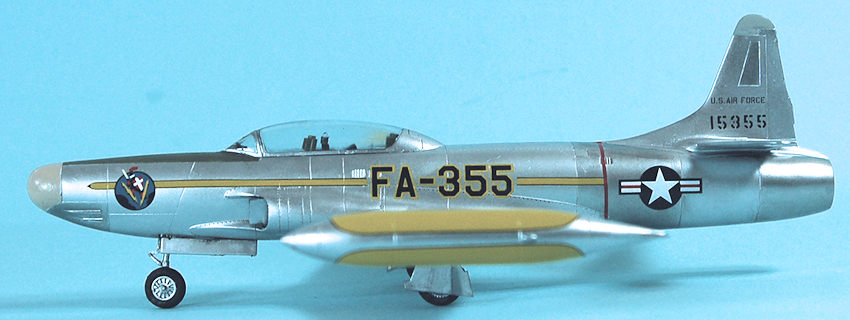
| KIT #: | HC1598 |
| PRICE: | $9.00 at estate sale |
| DECALS: | One option |
| REVIEWER: | Tom Cleaver |
| NOTES: | Experts Choice 48-33 F-94B Starfires 68 FIS & 319 FIS |

| HISTORY |
By 1948, it was clear that Curtiss XF-87 Nighthawk, expected to be the new Air Force’s first all-weather jet interceptor, was not going to live up to expectations. Northrop’s XF-89 had yet to fly, and would prove to need further development when it did later that year. There was a need for an “interim” all-weather jet interceptor. Lockheed presented a proposal to modify their new T-33 jet trainer, which appeared to need the least modification of any jet to perform the job.
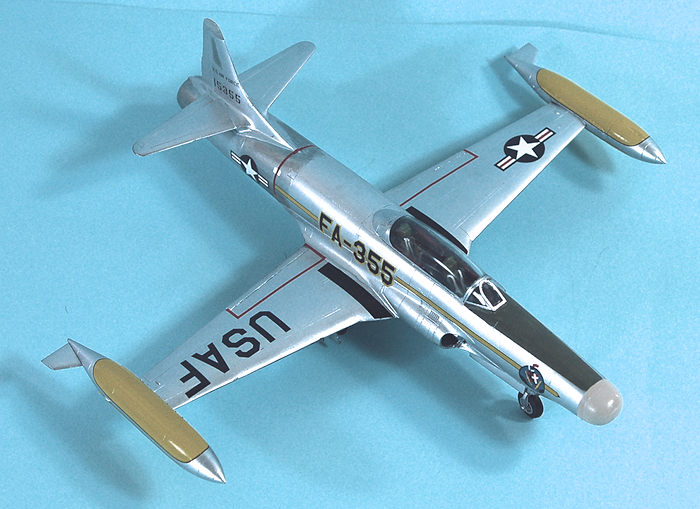 The TF-80C,
Lockheed’s prototype for the T-33, was modified with an APG-33 radar developed
from the radar used for the B-36 tail turret, an armament of four .50 caliber
machine guns, and the first afterburner to be used on an operational jet, as the
XF-94. It took flight in 1949 and appeared to meet all specifications. It was
ordered into production later that year as the F-94A (at the time, it had no
evocative name, since “Starfire” would not come along till the F-94C).
The TF-80C,
Lockheed’s prototype for the T-33, was modified with an APG-33 radar developed
from the radar used for the B-36 tail turret, an armament of four .50 caliber
machine guns, and the first afterburner to be used on an operational jet, as the
XF-94. It took flight in 1949 and appeared to meet all specifications. It was
ordered into production later that year as the F-94A (at the time, it had no
evocative name, since “Starfire” would not come along till the F-94C).
The 120 F-94As that appeared in 1950 did not live up to hopes. The engine and afterburner were not reliable, the cockpit was too tight for the crew to be able to operate successfully, and the radar needed tweaking. Lockheed modified the airplane to the F-94B with a more reliable engine, a modified cockpit that provided more room, and the radar was updated. 350 F-94Bs were ordered in 1951.
By late 1952, the
B-29 was forced to operate over North Korea at night due to the presence of the
MiG-15, and soon the Soviets were flying MiG-15s at night against the bombers.
Also, MiG-15s appeared over Seoul at night. The F-94B was dispatched to the far
east, where they replaced the F-82G Twin Mustang night fighters of the 68th
Fighter Interceptor Squadron. The airplanes made several interceptions over the
South Korean capital, which ended the intrusion by MiG-15s. The 319th FIS was
sent to Japan, and began operations from Suwon in January 1953, to provide CAP
for the B-29s over North Korea. This was a difficult assignment because it was
feared if one was lost over North Korea its equipment would be given t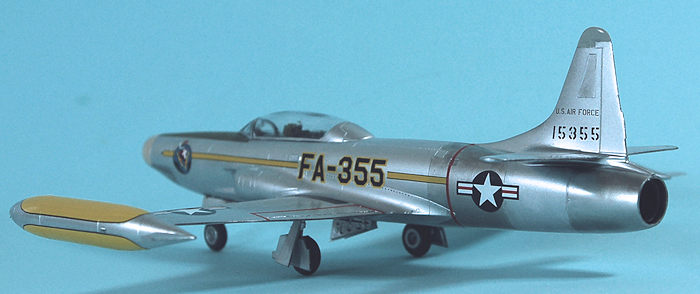 o the
Soviets, so the airplanes operated only in certain areas. Still, they managed to
intercept and shoot down several MiG-15s, alongside the Marine F3D-2 Skynight
night fighters that also provided escort protection to the B-29s. Thus, the
F-94B became the only USAF all weather jet interceptor to ever fire its guns in
anger and score victories.
o the
Soviets, so the airplanes operated only in certain areas. Still, they managed to
intercept and shoot down several MiG-15s, alongside the Marine F3D-2 Skynight
night fighters that also provided escort protection to the B-29s. Thus, the
F-94B became the only USAF all weather jet interceptor to ever fire its guns in
anger and score victories.
By 1953, the F-94C was in production, but the more advanced Starfire was not that superior to the earlier version, since it could not use its full rocket armament without danger of a flameout due to rocket blast. The F-94Bs continued to provide all-weather intercept with USAF and Air National Guard units throughout the 1950s, until it was fully replaced by the F-86D and F-102 in 1959.
| THE KIT |
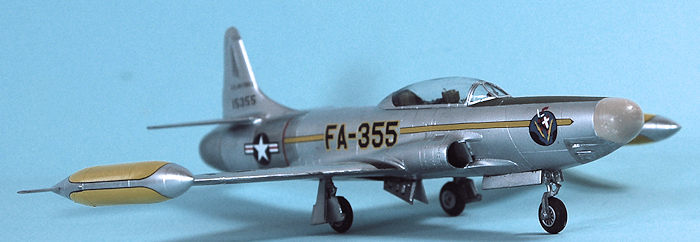 Hobbycraft’s F-94B is
the only 1/48 injection molded kit of this type ever released, in the early
1990s. The kit suffers from many of the same complaints leveled at the T-33, but
it is still the only game in town. Long out of production, it can still be found
on eBay and some dealers at shows. I found this one at an estate sale at the
LHS.
Hobbycraft’s F-94B is
the only 1/48 injection molded kit of this type ever released, in the early
1990s. The kit suffers from many of the same complaints leveled at the T-33, but
it is still the only game in town. Long out of production, it can still be found
on eBay and some dealers at shows. I found this one at an estate sale at the
LHS.
The decals for the kit are poor. Fortunately, Experts Choice and Repliscale released sheets for the airplane when the kit was in production, and these can also be found on eBay and from dealers. I found this sheet 48-33 at a local show.
| CONSTRUCTION |
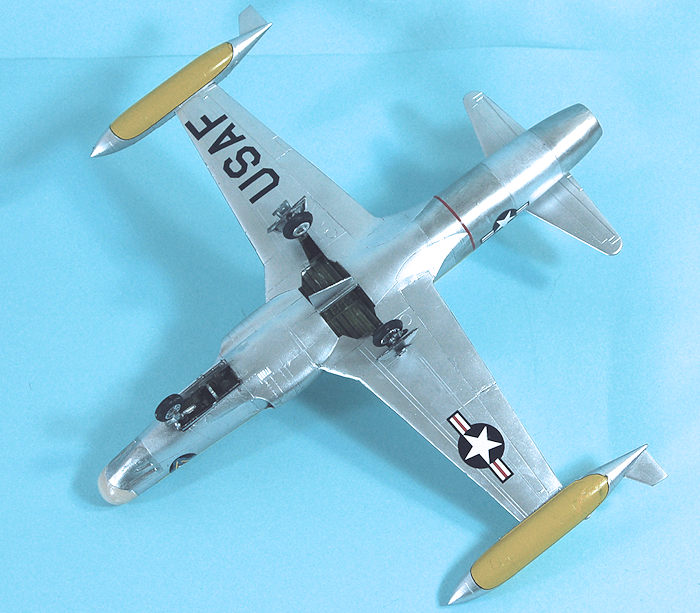 There was once a
resin cockpit for the T-33 kit, which could be modified for use here, but what
is provided is “good enough” if you close the canopy, which I did.
There was once a
resin cockpit for the T-33 kit, which could be modified for use here, but what
is provided is “good enough” if you close the canopy, which I did.
The fuselage goes together without problem, but like most kits of this period, fit is not perfect and you will need filler for the seams. It’s also a good idea to put some weights in the nose; I used several “cannonball” fishweights for this.
The kit is designed for the flaps to be lowered, but there is a paucity of interior detail in that area, and unless one wishes to spend time scratchbuilding detail, it’s better to close them. Of course, they don’t really fit all that well, which means you will be using some Mr. Surfacer 500 to clean things up. I also needed filler around the joints of the wing and fuselage when they were glued together.
Once everything was together, I sanded all the joints smooth, using several grits to get it as polished as possible for the coming natural metal finish, then rescribed panel lines as necessary.
| COLORS & MARKINGS |
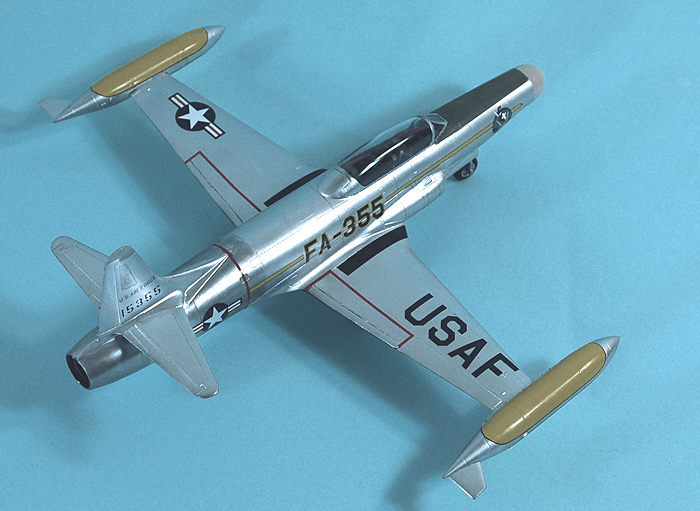 I applied an overall
coat of Tamiya Gloss Black, thinned 50-50 and misted on to the opacity desired
to get a very smooth surface for the primer. The Vallejo metal colors were used,
with the basic overall being Aluminum, with White Aluminum and Duraluminum used
for different panels. The anti-glare panel was painted with Tamiya Olive Green,
and the radome with Tamiya Desert Yellow lightened with White. There is more
difference between the panel line colors than shows up in the photos.
I applied an overall
coat of Tamiya Gloss Black, thinned 50-50 and misted on to the opacity desired
to get a very smooth surface for the primer. The Vallejo metal colors were used,
with the basic overall being Aluminum, with White Aluminum and Duraluminum used
for different panels. The anti-glare panel was painted with Tamiya Olive Green,
and the radome with Tamiya Desert Yellow lightened with White. There is more
difference between the panel line colors than shows up in the photos.
The Experts Choice decals went on without problem using Micro-Sol to melt them into position. The decals really made the model come alive at that point. I used the markings for the 68th FIS Second Flight, as seen in color photos of the airplane when based at Suwon, Korea, in 1953.
I attached the landing gear and unmasked the canopy. I didn’t need to use any clear varnish.
| CONCLUSIONS |
Not a perfect kit by any matter of means, but it builds into an acceptable model and fills a gap in anyone’s Korean War collection. Any modeler with a bit of experience will have no problem with this kit.
17 November 2016
Copyright ModelingMadness.com
Review kit and decals
courtesy of my wallet.